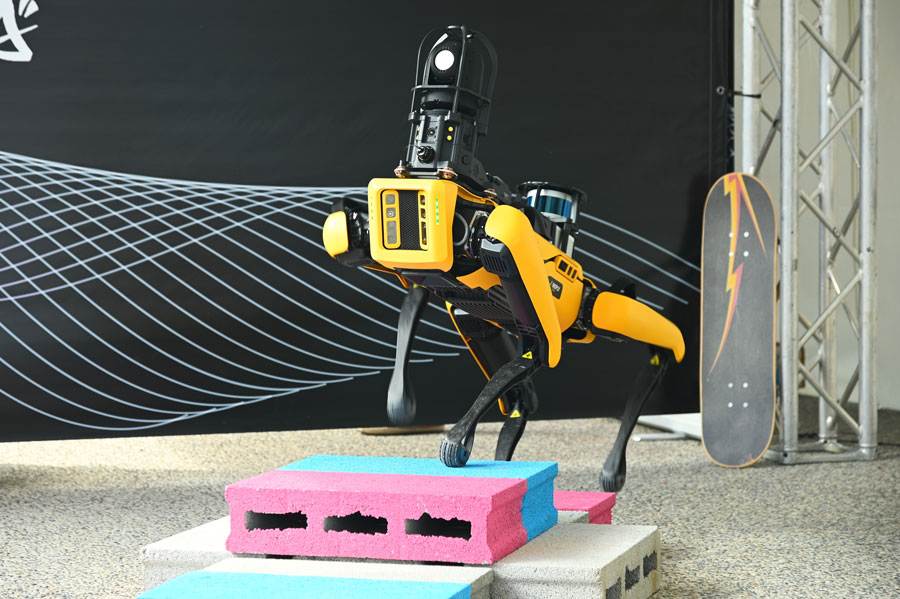
BAY SHORE, NY – A high-tech robotic quadruped known as “Spot,” developed by Boston Dynamics, is now being deployed across several construction sites on Long Island, marking a notable shift in how the construction industry is embracing automation and smart technology.
The 75-pound robot, resembling a mechanical dog, has been introduced at multiple Suffolk Construction projects, including the redevelopment of South Shore University Hospital in Bay Shore and a residential tower project in Brooklyn. Outfitted with cameras, sensors, and autonomous navigation software, Spot is tasked with conducting site walkthroughs, collecting 360-degree images, performing 3D scans, and identifying potential safety hazards in real time.
The robot’s integration into active construction zones is designed to increase operational efficiency, with Suffolk estimating a labor savings of up to two hours per day per project by automating routine inspections and documentation tasks. Spot can navigate stairs, avoid obstacles, and reroute itself around equipment and personnel, making it well-suited for dynamic and often hazardous construction environments.
In addition to improving safety compliance – such as identifying workers without proper protective equipment – Spot’s data-gathering capabilities enable project managers to monitor construction progress with greater precision. The robot’s visual and spatial mapping functions provide a “digital twin” of the worksite, allowing stakeholders to view progress remotely and identify issues early.
Suffolk Construction has been evaluating project sites for robotic integration based on criteria such as site size, access routes, and scheduling windows. Spot typically operates during early morning or off-peak hours to minimize disruptions to crews on the ground.
Beyond the job site, the robotic dog has also become a tool for community engagement. Suffolk has used Spot for educational outreach, demonstrating the technology to local schools as part of STEM awareness initiatives. Internally, the robot has been credited with boosting morale among workers, who often engage with it informally on the job.
The use of robotic systems in construction is part of a broader industry trend toward automation, digital documentation, and AI-enhanced project management. As Long Island continues to see infrastructure growth, tools like Spot may become a more common presence on job sites – serving both as a safety sentinel and a symbol of the industry’s evolving future.
Q&A: Spot the Robotic Dog on Long Island Construction Sites
Q: What is Spot, and who makes it?
A: Spot is a four-legged robotic platform developed by Boston Dynamics. It’s designed to autonomously navigate complex environments like construction sites, gathering visual and spatial data.
Q: Where is Spot being used on Long Island?
A: Spot has been deployed at several construction projects managed by Suffolk Construction, including the expansion of South Shore University Hospital in Bay Shore. It has also appeared at a high-rise development in Brooklyn, suggesting wider regional use.
Q: What exactly does Spot do at these sites?
A: Spot performs autonomous walkthroughs, capturing 360° photos and 3D scans. It helps monitor safety compliance, documents progress, and identifies potential hazards like unsecured areas or missing PPE.
Q: How does this technology help construction crews?
A: By automating routine inspections, Spot saves crews up to 1–2 hours of labor daily. The robot allows workers to focus on higher-level tasks like analysis, coordination, and problem-solving.
Q: Is Spot safe to use around people?
A: Yes. Spot is equipped with sensors and AI navigation, allowing it to avoid obstacles, reroute around people and equipment, and climb stairs. It’s designed to operate safely alongside human workers.
Q: How long can Spot operate before needing a recharge?
A: Spot runs on a lithium-ion battery that lasts up to 90 minutes per charge. Multiple robots or batteries may be rotated in and out to allow extended use across shifts.
Q: Are these robots replacing human jobs?
A: No. Spot is being used to enhance existing workflows, not replace workers. Its main function is data collection and safety monitoring, tasks that are repetitive but critical.
Q: How are workers reacting to the robot?
A: Reports suggest that crews have responded positively. Many workers enjoy interacting with Spot, and some see it as a sign that the company is innovating and staying ahead of industry trends.
Q: Are there plans to expand Spot’s use on other projects?
A: Yes. Suffolk Construction is evaluating new sites based on suitability—factors like project scale, complexity, and access all play a role. As the technology proves useful, wider adoption is likely.
Q: Why does this matter to the construction industry?
A: Spot’s deployment reflects a broader move toward automation, AI, and digital twin technology in construction. It enhances safety, reduces costs, and offers more accurate project oversight, signaling a shift in how modern job sites operate.


